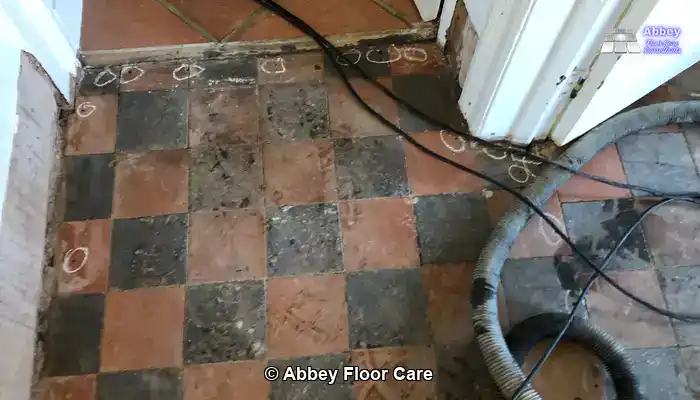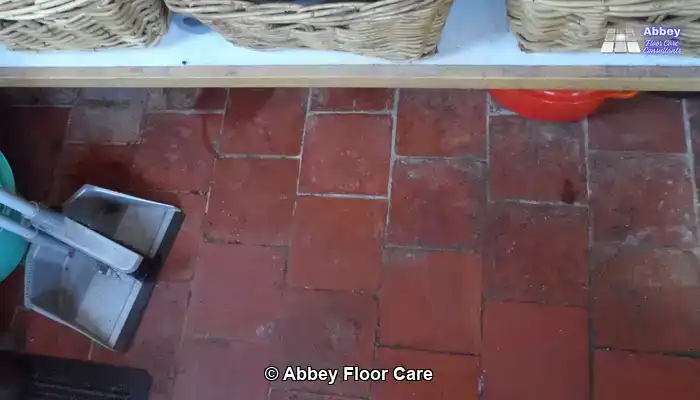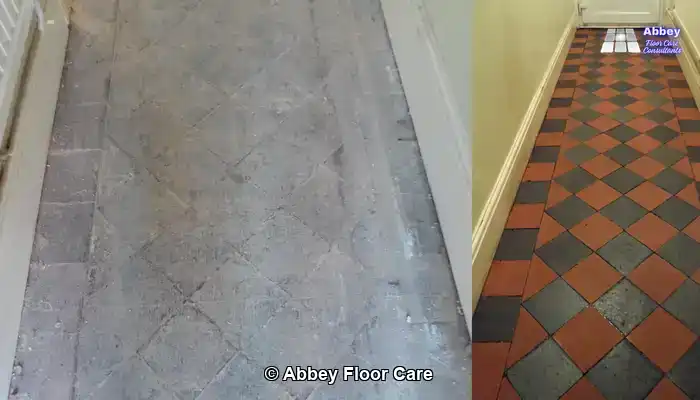
Last Updated on November 22, 2025 by David
Essential Insights for Deep Cleaning Quarry Tiles and Eradicating Decades of Grime
- Older homes featuring quarry tiles typically hide decades of entrenched grime, particularly in areas like kitchens and utility rooms where substances such as oil, wax, and dirt have seeped into the porous surfaces. This buildup significantly impacts both the aesthetic appeal and hygiene of the flooring.
- Utilizing industrial cleaning methods is vital for achieving comprehensive restoration, employing rotary scrubbers, alkaline degreasers, and dwell-based strippers like LTP Solvex to effectively dismantle stubborn grime layers.
- Sealing is an indispensable step following cleaning, utilizing breathable penetrating sealers to protect tiles without altering their natural appearance or topical sealers like LTP Ironwax Satin for added sheen, as long as damp conditions are absent.
- Post-cleaning DIY upkeep is achievable, using dry sweeping and pH-neutral cleaners to help maintain the finish and prevent future grime buildup, thus ensuring long-term care for your quarry tiles.
Why Is Deep Cleaning Crucial for Reviving Older Quarry Tile Floors?

Quarry tiles are celebrated for their durability; however, many older homes have these tiles that have absorbed significant amounts of oil, wax, and dirt over the years. In kitchens and utility rooms, these tiles often remain hidden beneath appliances or worn coverings, resulting in a concealed accumulation of grime. Homeowners seeking to rejuvenate their floors must confront challenges that extend beyond mere surface cleaning. This guide provides detailed methods for effectively addressing deeply embedded grime through industrial cleaning techniques that prioritize safety and efficiency, designed for sustainable property maintenance.
What Factors Lead to the Grime Buildup on Quarry Tiles?
Conditions in Kitchens and Utility Rooms That Encourage Grime Accumulation
High-traffic zones like kitchens and utility rooms expose quarry tiles to constant contact with cooking oils, spills, and heavy foot traffic. Over time, these substances do not merely rest on the surface; they infiltrate the porous clay, creating layers that resist standard cleaning methods. When tiles remain unsealed or poorly maintained, this absorption process accelerates, resulting in a floor that appears dull and uneven, even after regular mopping. Overcoming this issue necessitates a focused, industrial cleaning strategy aimed at restoring the tiles to their former glory.
The Impact of Oil, Wax, and Dirt: Understanding the Hidden Layers
Numerous older homes relied on wax-based polishes or oil treatments to safeguard quarry tiles. While these approaches provided temporary shine, they inadvertently trapped airborne dust and residues from cooking. As layers built up, they formed a sticky film that clung to soil particles. This predicament transcends aesthetics; it influences traction, hygiene, and the tile’s ability to breathe. Removing these layers requires more than simple scrubbing; it necessitates a blend of chemical breakdown and mechanical agitation to effectively revive the tiles.
How Can You Identify When Your Quarry Tiles Require a Deep Clean?

Visual and Tactile Indicators of Embedded Dirt on Your Tiles
It can be misleading to assume that a floor is clean simply because it appears red and uniform; however, quarry tiles often conceal grime beneath the surface. A freshly mopped floor may still feel sticky or greasy underfoot. If you wipe a damp cloth across the tile and it comes away dark or oily, this indicates the presence of deep-seated residues. Another crucial sign is an uneven sheen; areas that remain dull despite thorough scrubbing often signify wax buildup or dirt trapped beneath layers of old polish, underscoring the necessity for deep cleaning.
What Specific Factors Make Homes Especially Prone to Grime Accumulation?
Many residences possess older kitchens and utility rooms that have not undergone modernization for years. These areas often retain original quarry tiles that were either never sealed or treated with outdated wax products. Over time, layers of cooking oil, detergent runoff, and tracked-in dirt build up. Given that these tiles are porous and unglazed, they act like sponges, particularly in households with pets, children, or high foot traffic. Even if the surface appears intact, the underlying grime can adversely affect both hygiene and visual appeal, necessitating professional cleaning services.
Why Do Traditional DIY Cleaning Methods Often Fall Short for Heavy Grime Buildup?

What Are the Risks of Relying on Off-the-Shelf Cleaners for Deep Cleaning?
Most supermarket tile cleaners are formulated to address surface-level dirt. These products typically consist of mild surfactants or acidic components that may produce a temporary sheen but seldom penetrate the layers of wax, oil, and soil embedded within quarry tiles. In fact, frequent use of acidic cleaners can etch the surface, increasing porosity and susceptibility to future staining. Homeowners often find that despite regular cleaning, their tiles remain sticky or discolored — a clear indication that deeper intervention and professional techniques are essential.
Can Quarry Tiles Be Safely Restored Without Causing Damage?
The restoration process demands breaking down decades of buildup without harming the underlying clay. While quarry tiles are robust, they also absorb substances and can be sensitive to harsh treatments. Excessive scrubbing or improper chemical application can result in uneven outcomes or irreversible damage. Professional restoration methods depend on controlled chemical reactions and mechanical agitation tailored to the tile’s condition. Achieving this balance proves challenging with DIY equipment, which frequently lacks the necessary power and precision for safe and effective restoration.
Industrial Cleaning Techniques to Restore Quarry Tiles Effectively
Understanding Alkaline Cleaners and Sealer Strippers: Key Knowledge for Restoration
To dismantle years of grime, professionals utilize two primary chemical methods: alkaline degreasers and sealer strippers.
- Alkaline cleaners excel at eliminating organic residues such as cooking oils, general soil, and everyday grime. They function by emulsifying grease, allowing for rinsing without damaging the tile.
- Solvent-based sealer removers are necessary when waxes, topical sealers, or polish layers are present. These traditional solvent-based strippers dissolve synthetic coatings effectively but can be harsh and produce strong fumes.
- Non-solvent sealer removers, such as LTP Solvex, provide a safer alternative. These non-solvent strippers gradually penetrate the sealer and soften it, similar to how paint strippers dismantle old coatings. Unlike immediate dissolution, they necessitate a dwell time of several hours or overnight. Once softened, the residue is removed mechanically with scrubbing pads and water.
Choosing the appropriate product relies on your available time, your tolerance for strong odors, and the nature of the buildup you are confronting. For deep restoration, especially where old sealers exist, a dwell-based stripper like LTP Solvex offers a more measured and less aggressive approach. This method allows for gradual softening of the sealer, facilitating its removal with scrubbing pads and water, without relying on harsh solvents or rapid chemical breakdown.
Evaluating Rotary Scrubbers Versus Manual Brushing Techniques for Effective Cleaning
Mechanical agitation is pivotal in restoring quarry tiles. Rotary scrubbers utilize weighted heads and stiff brushes to drive cleaning agents deep into the tile’s surface. This technique proves vastly more effective than manual brushing, which typically only skims the surface and leaves residues behind. The combination of chemical dwell time and machine pressure guarantees that embedded grime is lifted without damaging the clay. For larger areas or severe buildup, rotary machines consistently deliver results that manual methods cannot match.
How to Select the Right Chemicals for Quarry Tile Restoration
Ensuring Safe Application of High-pH Cleaners for Effective Cleaning
Alkaline cleaners with a high pH are crucial for dismantling organic grime, but they must be applied properly. These powerful degreasers engage with oils and fats, extracting them from the tile’s surface. However, they require careful dilution and adequate dwell time to avoid streaking or residue formation. In professional settings, technicians first test small areas and carefully monitor the reaction. Homeowners attempting this without proper training risk uneven outcomes or chemical burns to surrounding surfaces, leading to additional complications during the restoration process.
When Should Stripping Treatments Be Used for Maximum Effectiveness?
Solvent strippers are deployed when wax, polish, or synthetic sealers have accumulated over time. These chemicals dissolve the coatings that trap grime beneath the surface, enabling thorough cleaning of the tiles. Since solvents can emit strong fumes and affect indoor air quality, they should only be used in well-ventilated areas while wearing protective gear. In older homes, chemical stripping often becomes the only feasible method for reaching the original tile surface, especially in kitchens where wax-based treatments were prevalent.
Understanding Mechanical Agitation: Its Definition and Importance for Effective Cleaning
How Rotary Machines Efficiently Dislodge Embedded Grime from Tiles
Rotary machines utilize weighted heads and stiff bristle pads to agitate the surface of quarry tiles. This process involves more than merely scrubbing harder; it requires consistent pressure and motion to dislodge grime from deep within the tile’s pores. The machine’s rotation helps emulsify dirt, allowing it to rise to the surface for safe rinsing. Without this mechanical lift, even powerful chemicals may leave behind residues, making thorough cleaning unattainable.
Our company employs these machines for most floor cleaning tasks, utilizing hand pads for corners and edges that mechanical brushes and pads cannot effectively reach.

Recognizing the Importance of Pressure and Dwell Time in Cleaning Effectively
Effective cleaning relies on more than just having the right tools available. The pressure applied by the machine and the duration the chemical remains on the tile—referred to as dwell time—are critical factors. Insufficient dwell time can lead to ineffective breakdown of grime, while excessive pressure poses a risk of damaging the tile’s surface. Professionals meticulously calibrate these variables based on the tile’s condition, ensuring a thorough clean while protecting the floor’s integrity and appearance.
Essential Post-Cleaning Procedures: The Significance of Sealing and Long-Term Care
How to Identify When and What to Seal After Cleaning for Optimal Protection
Once quarry tiles have been meticulously cleaned and completely dried, sealing becomes a crucial step to safeguard them from future stains and damage. A well-executed sealing process ensures that the tiles retain their restored appearance and resist the absorption of dirt and oils.
Choosing Between Impregnating or Penetrating Sealers for Optimal Results
A breathable, penetrating sealer is ideal for unglazed clay surfaces, particularly on floors lacking a damp-proof membrane. These products penetrate the tile and form a barrier that repels oils and water while preserving the tile’s natural look. Timing is vital; sealing too soon after cleaning risks trapping moisture, while delaying too long allows new dirt to settle. Typically, sealing should occur within 24 to 48 hours following cleaning, provided the tiles are completely dry to ensure maximum effectiveness.
For a Desired Sheen, Topical Sealers Are Worth Considering
If you prefer a satin or gloss finish, a topical sealer like LTP Ironwax Satin serves as a practical solution. These sealers create a surface layer on the tile, imparting a subtle sheen while helping to conceal minor surface imperfections. They can also simplify cleaning—especially on older quarry tiles that may display surface damage or crevices where dirt tends to accumulate. However, topical sealers are not advisable for damp-prone floors. Since they form a surface film, any moisture trapped underneath can lead to whitening, flaking, or adhesion issues. Always ensure that the floor is entirely dry and free from rising damp before applying a topical finish.
What Is the Recommended Frequency for Cleaning and Resealing Quarry Tiles to Maintain Their Condition?
Sealing is not a one-time solution; it necessitates regular maintenance. In high-traffic areas such as kitchens and utility rooms, the protective layer diminishes over time. Most quarry tile floors benefit from resealing every 2 to 4 years, depending on usage and cleaning practices. Consistent maintenance—such as dry sweeping and the use of pH-neutral cleaners—extends the lifespan of the sealer. If tiles begin to absorb water rapidly or show signs of darkening when wet, it indicates that the sealer has worn off and requires reapplication to preserve their appearance and condition.
Frequently Asked Questions by Homeowners About Quarry Tile Care
Will Deep Cleaning Alter the Color of My Quarry Tiles?
In most instances, deep cleaning restores the original color of the tiles rather than changing it. Decades of grime may have darkened or dulled the surface, so when these layers are removed, the tile may appear brighter or more vibrant. This phenomenon does not indicate a color change; instead, it reflects a return to the tile’s natural state. If wax or polish has yellowed over time, stripping it away can unveil the true tone underneath, enhancing the overall aesthetic of your flooring.
Is the Quarry Tile Restoration Process Messy or Disruptive?
While industrial cleaning involves machinery and chemicals, the procedure is systematic and contained. Rotary scrubbers utilize minimal water and efficiently extract waste as cleaning progresses. Many homeowners are pleasantly surprised by how neat the process is, particularly in contrast to DIY efforts that often leave streaks or residues behind. Adequate ventilation and preparation significantly reduce disruption, making it a manageable undertaking even in busy households.
Can I Sustain the Results Achieved Through Professional Cleaning Over Time?
Absolutely — once the tiles have been restored and sealed, ongoing maintenance is straightforward. Regular dry sweeping and occasional mopping with pH-neutral cleaners will keep the surface clean without compromising the sealer. Avoid using acidic or bleach-based products, as these can degrade the protective layer over time. With proper care, restored quarry tiles can remain visually striking and fully functional for many years, even in high-traffic environments where durability is crucial.
The article Deep Cleaning Quarry Tiles: Removing Decades of Grime first appeared on https://www.abbeyfloorcare.co.uk
The article Deep Cleaning Quarry Tiles: Eradicating Years of Dirt appeared first on https://fabritec.org
The Article Quarry Tiles Deep Cleaning: Banish Years of Grime Was Found On https://limitsofstrategy.com

